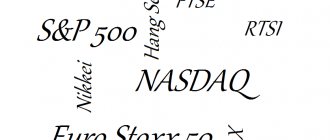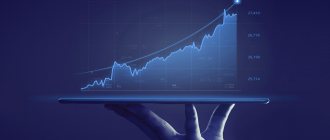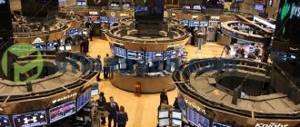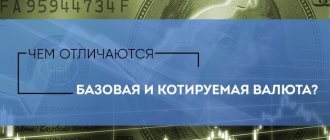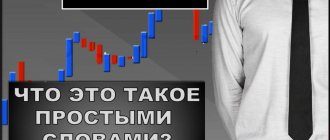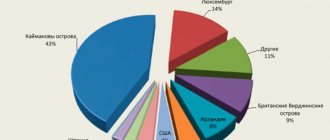Want the ease of stock trading but the diversification benefits of mutual funds? Take a look at exchange-traded funds (ETFs) that combine the best of both.
This article provides information and education for investors. Ardma.ru does not offer advisory or brokerage services, and does not recommend or advise investors to buy or sell specific stocks or securities.
Exchange-traded funds are a type of investment fund that offer the best characteristics of two popular assets: They have the diversification benefits of mutual funds while mimicking the ease of trading stocks.
What is an ETF in simple words?
ETF (decoding, Exchange Traded Fund) - literal translation, funds traded on the exchange.
In simple words, an ETF is a portfolio (basket) of securities collected according to a certain principle. Most often based on an index. For example, shares from the S&P 500 index or the Moscow Exchange. Securities are purchased in the same proportion as in the index. Parts of this ETF portfolio (shares) are sold on the stock exchange.
As a result, an investor who buys even one share of an ETF invests money in several shares of different companies at once.
Using an example from life.
You wanted to eat some pie. What do you need for this?
Find a recipe (if you don’t know how to cook). Go to a store or market. Find and buy the necessary ingredients.
Spend time cooking. And it’s not a fact that it will turn out delicious.
As a result, you spent a lot of time and money. They baked a huge pie. Although they only wanted one piece. And there are still unused products left.
Tomorrow we wanted some other exotic dish. Buy groceries and cook again?
Well, yes. So what to do?
Or you can go to a cafe (canteen, restaurant). The cook has already prepared a delicious pie.
We bought one portion (not the whole thing). Eat and enjoy life.
ETFs work the same way. Fund providers assemble a product from various securities (ingredients). And they sell everyone a piece (two or three, depending on how much they need) of this pie. Or other "dishes". For little money.
Of course not for thanks. You will have to pay a management fee to own ETFs.
What are the fees for ETFs?
Russian funds ask for management on average about 1% per year.
ETF from Finex investing in stocks - 0.9%. Bonds - 0.45 - 0.95%.
Fund provider ITI - 0.65%
BPIF (not quite an ETF, but close) from VTB, Sberbank, Alfa - from 0.5 to 1.1%.
American ETFs are more economical for investors in this regard. The management fee can be 10-20 and even 50 times lower than Russian analogues. There are even free funds. No annual management fee.
For example, Vanguard's S&P 500 ETF charges 0.03% for the year.
Popular ETFs, with a capitalization of tens to hundreds of billions of dollars, on average want 0.03-0.15% for their money.
Management costs of the largest ETFs
FXIT or FXUS
Rising inflation amid money printing could accelerate the Materials sector, which is at the bottom and is included in the S&P500.
Reducing production capacity will sooner or later lead to a shortage of goods.
Overheating of the Nasdaq index relative to small-cap companies (Russel 2000).
Nobody needs undervalued companies; everyone has recently chosen growth companies, only inflating the bubble.
Summary : FXIT is more likely to be overheated, FXUS looks like the most conservative investment, but with less upside potential.
The most prudent option would be to wait for the correction (if your investment horizon is less than 15 years).
This is just one sector of the economy, others should be added when adding to the portfolio.
How is the management fee calculated?
The so-called ETF management fee is indicated as a percentage of NAV (net assets). For an annual interval. But it is charged daily. Proportional to the holding period of the fund's shares.
For example. The indicated management fee is 1.1% per year. An investor buys 10 ETF shares for 10,000 rubles.
The fund's daily commission will be about 0.003%. Or 30 kopecks a day.
The money is debited from the value of the fund's shares. By making the estimated price of one ETF less by the amount sought. In our case, 3 kopecks per share. For each day of ownership.
pros
- You can buy both for rubles and for $ .
- Wide diversification within ( 506 companies ).
- A large number of manufacturing companies lagging behind the Tech sector.
- You can buy it on IIS, LDV is valid.
- Dividend tax has been reduced from 30% to 15% .
- Fees will decrease as NAV (net asset value) increases. Essentially new participants.
- The American economy is one of the strongest in the world.
- Protection against devaluation.
- Since 2013 on the Moscow Exchange.
- High tracking accuracy.
What types of ETFs are there?
ETFs are mainly divided according to investment strategies:
- passive;
- active.
The passive strategy based on following a stock index. Papers are purchased in a similar proportion. The standard can be indices on stocks, bonds or commodity assets (gold).
The main goal is to obtain a return comparable to the growth of the index. Keeping the ETF composition up to date requires minimal effort from the provider. And typically, the management fee will be much lower (but not always). Compared to actively managed strategies.
Active funds try to beat the index. And get returns higher than what passively managed ETFs can provide. True, this does not always work out.
Assets are collected into a fund according to a given criterion or its own algorithm.
- ETF with leverage - if the market grows by 5%, the investor receives 2 or 3 times the return. True, when it falls, the loss also increases significantly.
- Reversible funds - when the market falls, investors receive income and vice versa.
- Shares that pay dividends. For example, dividend aristocrats. The companies included in the fund have consistently paid dividends for 10-25 years. Or companies with the highest level of dividend yield are selected.
The bulk of ETFs are passive or index funds. With more predictable results. And low risks.
How to Find the Right ETFs for Your Portfolio
It's important to know that while ETF costs are generally lower, they can also vary widely from fund to fund, depending on the issuer, as well as complexity and demand. Even ETFs that track the same index have different costs.
Most ETFs are passively managed investments; they simply track the index. Some investors prefer the hands-on approach of mutual funds, which are managed by a professional manager who tries to do better than others in the market. There are actively managed ETFs that mimic mutual funds, but they have higher fees. So consider your investing style before purchasing.
The explosive growth of this market has also led to the introduction of some funds into the market that may not have merit - gimmicky funds that occupy a thin slice of the investment world and cannot provide much diversification. Just because an ETF is cheap doesn't necessarily mean it fits your broader investment thesis.
Where to buy ETFs?
Since ETFs are traded on the stock exchange, you can buy them there. To do this you will need to gain access to trading. Through a broker.
A broker is an intermediary between investors and the exchange.
The algorithm is as follows:
- Choose a reliable broker with adequate rates.
- You enter into a brokerage service agreement with him (many allow you to open an account online, without visiting the office).
- You fund your account and make transactions (purchase ETFs) through a trading terminal or mobile application.
How to choose a stock market broker?
The best Russian brokers for beginners.
Exchange-traded funds can be purchased:
- on the Moscow Exchange (access is provided by any Russian broker);
- on the St. Petersburg stock exchange (not all brokers have access);
- through a foreign broker.
ETF on the Moscow Exchange
Almost 3 dozen ETFs and mutual funds are available to investors. Mainly on stock and bond indices. Developed (USA, Germany, England, Japan, Australia), developing (China, Russia, Kazakhstan) markets.
Both from providers (FINEX, ITI) and the largest banks (Sberbank, VTB, ALFA, Gazprombank).
The current list of all funds available for purchase can be viewed on the Moscow Exchange website. Quotes, name, stock ticker and description of the ETF (presentation).
ETF on the St. Petersburg Exchange
The St. Petersburg Stock Exchange trades foreign ETFs. There are currently 77 funds available from the world's leading providers:
- Vanguard;
- iShares;
- SPDR;
- Invesco.
The current list of ETFs can be viewed on the St. Petersburg Exchange website.
ETF trading is closed to ordinary mortals. Qualified investor status is required.
Foreign ETFs
The number of ETFs available for purchase in Russia is negligible. The problem is solved by contacting a foreign broker. As a result, the investor gets access to several thousand global ETFs. With lower commissions.
Important! The benefit of purchasing an ETF with a lower management fee (hundredths of a percent) may be offset by the higher costs of maintaining a foreign brokerage account.
In other words. Owning foreign ETFs will be much cheaper. But the total commissions for transactions + a possible mandatory monthly fee to a foreign broker are many times more expensive.
As a result, contacting a foreign broker will be advisable with a certain amount of capital. From 10-15 thousand dollars minimum.
Info on the topic: How much is it profitable to work with a foreign broker?
What ETFs can you buy? What are their profitability, expenses, dividends?
There are 2 resources that provide information on most of the world's ETFs. With the ability to filter and search for the funds you need:
- etfdb.com;
- etf.com.
Composition RUSB
The RUSB investment fund covers five main sectors of the Russian economy - state property management, energy, industrial, raw materials and financial markets. The list of assets included in the portfolio is periodically updated based on indicators. Rebalancing is carried out quarterly. As of 2021, the fund consists of Eurobonds of 14 issuers.
The exchange-traded fund, in particular, includes the following major participants of the Moscow Exchange:
- Gazprom is a transnational supplier of natural gas;
- Alrosa is a leader in the diamond mining industry;
- Alfa-Bank and VTB are commercial financial organizations;
- MMC Norilsk Nickel is the largest producer of nickel, palladium, platinum and copper;
- Lukoil and Sibneft are among the main oil companies in the country.
Before purchasing, it is recommended to clarify the composition of the portfolio - a description can be found on financial portals or on the MICEX website.
Average ETF Return
How much can you earn by investing in ETFs?
In the short term, no one can give an accurate forecast. Investors can receive both profits (+10, 20, 30-40% per year) and losses. It all depends on the state and dynamics of the stock markets in each specific period of time.
But over long time intervals, there is a statistically confirmed average annual return.
- The stock market is growing by an average of 4-6% per year.
- Bonds can yield 1-2%.
Above inflation.
For those interested:
Dynamics of US stock market returns over 3 centuries.
Profit statistics by country (stocks and bonds).
Growth of country and world indices in the 21st century.
You can roughly focus on the presented indicators when making decisions about investing in ETFs.
FXGD
Since 2015, the fund has been called FinEx Gold ETF. Some investors believe he is buying physical gold. But in fact, the fund invests in gold in a “synthetic” way.
Essentially, the fund invests in short American notes and American bond ETFs. To justify its name (the fund is still “gold”), FinEx entered into an agreement called “Total Return Swap for Gold” with UBS AG bank. In a swap, the parties exchange payments upon the occurrence of a specified event. To put it simply, when the price of gold rises, FXGD receives payments from UBS AG and places them in notes and ETFs. If gold falls, the fund sells part of its assets and transfers the money to the bank.
As a result of such simple operations, FXGD is able to follow the dynamics of the price of gold on the London Bullion Market (LBMA). Therefore, such an ETF can be safely considered as a hedging instrument against falling stocks - after all, during a crisis, gold usually rises.
The FXGD share price is 680 rubles at the time of writing this review. The annual yield in rubles is 13%, in dollars – 18%. Management fee – 0.45%.
Mutual Fund or ETF
What's better? Mutual fund or ETF?
The main difference comes from two things.
- Commissions. As a rule, mutual funds have higher management costs. The gap can be several times. And expenses for the investor automatically reduce net profit. Some Russian mutual funds don't bother at all. Buys foreign ETFs, wraps it in its own product. And they sell it to investors. Naturally with a much higher management fee.
- Strict adherence to strategy. If we take ETFs and mutual funds that focus on an index strategy, then the human factor is excluded from ETFs. Securities in the fund are purchased in proportions that coincide with the benchmark. Mutual fund managers can take “liberties” in the form of changing strategy, buying more of one asset and less of another. As a result, this may present unpleasant surprises to investors, in the form of a lag behind the index in terms of profitability.
The difference between BPIF and ETF is described in more detail here.
ETFs and mutual funds
Generally speaking, ETFs have lower fees than mutual funds (MIFs)—and that's a big part of their appeal. In 2021, the average annual administrative expense (also called expense ratio) for mutual funds was 0.52%. The average expense ratio for ETFs was 0.18%.
ETFs also offer tax efficiency benefits to investors. Typically, turnover within a mutual fund (especially an actively managed one) is higher than that of an ETF, and such buying and selling can result in capital gains. Similarly, when investors go to sell a mutual fund, the manager will need to raise cash by selling securities, which can also generate capital gains. In any case, investors will be forced to pay these taxes.
ETFs are becoming more popular, but the number of mutual funds available is still higher. The two products also have different management structures (usually active for mutual funds, passive for ETFs, although actively managed ETFs do exist).
Do the funds pay dividends?
Yes and no.
The European model assumes full reinvestment of dividends. Incoming cash flow increases the price of the fund's shares.
Owners of American ETFs receive constant payments from dividends or coupons. Payments generally occur 4 times a year (every quarter). Less than 2 times a year. There are funds that pay divas every month. But there are few of them.
Of course, both European and American ETFs have exceptions. Some Americans may choose to reinvest instead of paying divas. Like the Europeans, pay out money to their shareholders.
But the majority of funds work this way.
What is in Russia?
Introduced in 2013, Finex ETFs initially paid dividends. But after a year they abandoned this practice. And we switched to the European model of income reinvestment.
ETFs and BPIFs traded on the Moscow Exchange do not pay dividends.
The exception is the RUSE ETF from ITI Funds. Investing in the Moscow Exchange index. Once a year, the provider accrues dividend income to shareholders. Real money.
Investor reviews
Vyacheslav, 41 years old, Yekaterinburg: “Quotations for the FXRU fund show positive dynamics. The price per share quickly recovered after the market crash due to the coronavirus. That is why it is called almost risk-free. Another advantage is the automatic reinvestment of funds, which eliminates the need for investors to do it themselves.”
Ksenia, 29 years old, Rostov-on-Don: “It is profitable to purchase FXRU ETF. There is no need to spend hundreds of thousands of rubles to purchase Eurobonds. At the same time, you can get maximum diversification by purchasing only 1 share of the fund. It includes Eurobonds of Sberbank, Gazprom, Norilsk Nickel and other companies that are showing active growth.”
Taxation of ETFs in Russia
For funds traded on the Moscow Exchange, the standard tax rate applies. 13% from profit.
Both due to the growth in value and the dividends received.
For foreign ETFs purchased through a foreign broker, you may be subject to a 30% tax.
It can be reduced to 13%. Countries such as Russia and the United States have signed an agreement on the avoidance of double taxation. To do this, you need to fill out form W-8BEN (I wrote how to do this here).
As a result, when receiving income from an ETF (upon sale or receipt of dividends), the American broker will automatically withhold 10% in the form of income tax. The remaining 3% will need to be paid in the Russian Federation. After the end of the calendar year. Fill out a tax return (calculating the amount of tax remaining to be paid yourself).
In this regard, it is easier for Russian investors working with domestic products. The broker is a tax agent. And he himself calculates and withholds 13% tax from the client.
ETF Benefits
This concerns Russian funds again.
If you own securities for more than 3 years, you are exempt from tax on the increase in market value. By 3 million each year.
It is possible to purchase ETFs within an IIS. And the right to claim 2 types of tax deductions (to choose from):
- 13% refund of the account replenishment amount;
- exemption from capital growth tax.
“Foreigners” cannot offer similar tax breaks to non-residents.
Useful: Everything you need to know about IIS before opening
Differences from FXRB
FXRB ETF is a ruble investment fund of Eurobonds of Russian companies.
Differences between FXRU and FXRB.
FXRU and FXRB are considered "counterparts". They include the same Eurobonds of the largest issuers in the same proportion.
However, despite this, several differences can be distinguished:
- FXRB has the opportunity to receive a forward premium - additional profitability due to the dominance of the ruble rate over the dollar rate.
- The commission in the ruble fund is slightly higher and amounts to 0.95% * 1/365, and not 0.5% * 1/365, as in the dollar fund.
Comparative characteristics of ETFs
| № | Criterion | FXRU | FXRB |
| 1 | Entry threshold | <1000 rub. | <2000 rub. |
| 2 | Diversification | High | High |
| 3 | Currency | USD | RUB |
| 4 | Currency hedge | No | Eat |
| 5 | Limited time | No | No |
| 6 | Repayment at the end of the term | No | No |
| 7 | Automatic reinvestment of coupons | Yes | Yes |
| 8 | Purchase method | Exchange | Exchange |
| 9 | Placement on IIS | Eat | Eat |
| 10 | Three-year benefit | Eat | Eat |
What is better - buying in dollars or rubles?
On the Moscow Exchange, the same ETFs are traded in two currencies: rubles and dollars.
What is better and more profitable for an investor?
The answer is simple - buy ETFs in the currency that you have in hand.
Special currency conversion (for example, buying dollars for rubles) in order to buy dollar ETFs is fraught with additional costs. You will have to pay a commission for buying and selling currency on the exchange.
The same goes for selling. When you need money, after selling dollar ETFs, you will have to do a reverse currency conversion again. With new costs.
And with many brokers, exchange is carried out in lots, multiples of 1,000 CU. As a result, you will almost always have some funds left that will have nowhere to invest. And they will lie like a dead weight on the account.
Bought 1000 dollars for rubles. We purchased almost all ETFs. There will be a few dollars left that are not enough to buy one more share of the fund. Not scary. After a while, you decide to take profits and sell all dollar ETFs. From the initial investment of one thousand, the capital increased to $1,500.
1000 can be easily exchanged on the foreign exchange exchange. But what to do with the remaining amount?
There is no difference in terms of future returns. Will you buy ETFs in rubles or dollars?
ETF quotes are linked to assets (securities). And the exchange rate. As the dollar rises, ruble ETFs will automatically rise in price. And vice versa.
FXKZ
One of the youngest FinEx funds - FFIN Kazakhstan Equity ETF - offers investments in the largest shares of Kazakhstan. The fund tracks the Kazakhstan Stock Exchange Index (KASE Index). Now there are only 8 issuers: Bank CenterCredit, KAZ Minerals, People's Bank of Kazakhstan, Kcell, KEGOC, NAC Kazatomprom, Kazakhtelecom, KazTransOil.
In Kazakhstan, there has been an economic transition from the category of the “threshold” market (frontier) to the camp of developing countries (emerging market). In addition, the creation of a free economic zone (a kind of internal offshore) in Kazakhstan to attract foreign companies is currently being considered. If technology startups and giants start holding IPOs in Kazakhstan, this will significantly move the index up.
The fund is still young, it is too early to talk about long-term profitability. Since its inception, the increase in profitability in rubles has been only 0.1%, in dollar equivalent – 5%. You can only buy shares for rubles. Price – 183 rubles. This is almost the cheapest ETF from the entire line of FinEx exchange-traded funds; only global funds are cheaper.
The fund’s commission, by the way, is the largest of all Phoenix ones - as much as 1.39%. And the tracking error is quite high - 2.26%. But this is explained by the youth of the fund and the small volume of assets, with which it is difficult to rebalance. So this ETF has everything ahead.
And here’s another interesting article: ETFs with the highest dividends: TOP 10 funds
Is it possible to buy ETFs on an IIS?
All funds traded on the Moscow Exchange are available for purchase on the IIS.
With a small caveat. Some brokers do not allow you to buy ETFs denominated in dollars into your investment account. But rubles are no problem.
How to buy ETF on IIS in dollars?
- On the foreign exchange exchange we exchange rubles for dollars. Trading is carried out in multiples of lots. 1 lot = 1,000 dollars.
- We buy dollar ETFs.
- Some brokers provide the service of buying and selling currencies in partial lots. Up to 1 dollar.
Review of the Eurobond fund of Russian companies FXRU ETF
Today, investors are showing great interest in risk-free securities. These include the FXRU ETF. This is a dollar investment exchange-traded fund of Eurobonds of the largest Russian companies, the portfolio of which includes 25 different bond issues in foreign currency.
For the most part, these assets are intended for institutional investors, which include insurance companies, pension funds, and investment holdings. Eurobonds can also be purchased by a private investor, for whom it is the most reliable asset that generates profit in foreign currency.
Story
The Russian Eurobond Fund has been in circulation since February 6, 2013. Over 7 years, the return was 42% in dollars (282% in rubles). The average annual return is 5% in dollars (17% in rubles).
Over the entire period of the fund’s existence, negative returns were observed only in 2014. This was due to the currency crisis caused by the fall of the ruble against foreign currencies due to a sharp decline in oil prices on the world market. During this period, investing in Russian companies was considered a risky strategy.
